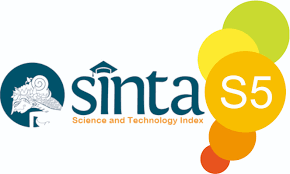Mapping Strategy Development Of Traveler Destinations In Empowerment Local Community East Coast In South Sulawesi
 Abstract views: 541
,
Abstract views: 541
,
 PDF downloads: 371
PDF downloads: 371
Abstract
Research carried out to identify, analyze, and orientation of the mapping strategy to support the development of tourism destinations empowering local communities and area-based tourism as its leading sector. The approach used is qualitative and quantitative mix techniques. The results showed that developments rating in Sinjai can be seen from 1) traveller, 2) traveller destination, 3) traveller activities, 4) of accommodation used, 5) traveller trips, 6) average expenditure, 7) characteristics of the traveller market. From the description of the results of the study has increased every year. This is because adequate infrastructure increasingly supported sights. The mapping showed an increase and expansion of the traveller area each year. Increased traveller destinations and the availability of adequate infrastructure provide the opportunity for local communities to take part in the tourism industry that contributes to the empowerment of local communities. The government's efforts in promoting the expansion of development opportunities in various sectors of the tourism sector strongly support the improvement of the economy and social life at the local community level.
Downloads
References
Andi Cudai Nur & Haedar Akib, 2018. Mapping of Local Competence BaseIntegrated Tourism Destination Development On the East Coast of South Sulawesi, UNM Research Center, Makassar
Cole, S. (2007). Beyond Authenticity And Commodification. Annals Of Tourism Research. Vol. 34 No.4 2007
Creswell, JW (2011). Research Design: Qualitative Approach, Quantitative, and Mixed. Yogyakarta: Student Library.
Gunn, Clare A. (1994). Tourism Planning: BasicConcept andCases. Taylor andFrancis:Washington Dc.
Gruber, James (2008), Key Priciples of Community Based Natural Resource Management: A Synthesis and Interpreatation of Identified Effective a Approaches for Managing The Commons. Antioch University New England
Harry, Wisdom. 2010. Community Empowerment Strategy, Bandung: Main Humanities Press
Heene, A., & et al. (2010). Public Organizational Strategic Management. Bandung: Refika Aditama.
Hidayat, M. (2011). Planning And Development Strategy Attractions (Case Study Pangandaran beach in Ciamis regency, West Java). THE) Journal, I (1), 33-44.
Kurniati, E.D. (2015). Industrial Entrepreneurship. Deepublish
Ismayanti. (2011). Introduction to Tourism. Jakarta: Grasindo.
Pendit, S. (2006). Ilmu Pariwisata. Jakarta: PT. Pradiya Paramita
Putra, M.F.P. 2017. Mixing methods: an alternative research in sports science. Proceedings of the LPTK VIII National Sports Seminar. Yogyakarta: UNY.
Morrissey, Janice. (2000). "Indicators of Citizen Participation: Lessons From Learning Teams in EZ/EC Communities"Community Development Journal (Oxford Journal) Vo. 35. No.1 January 2000. 59-74
Robaaniyahya, R. (2016). The Role of Social Institutions for Empowering Women and Children at the Edge of Seroja in Dealing with Vulnerable Children in the City of Solo. Sebelas Maret University: https://digilib.uns.ac.id
Santi, Ni Made. 2017. Study of Marine Tourism Against Community Welfare in the Coastal Areas of Nusa Penida Island, Bali, Bogor: IPB
Suharto, Eddie. 2005. Building a Community Empowering People, Bandung: Aditama
Simanjuntak, BA, Cape, F., & Nasution, R. (2017). Tourism History: Towards Development of Tourism in Indonesia. Jakarta: Indonesian Torch Reader.
Stratan, Alexandru. Perciun, Rodica and Gribincea, Corina. (2015), Cultural Tourism Potentials In Republic of Moldova Through Cultural Comsumption Among Tourists. Vol. 188
Sugiono. (2017). Research Methods Combined (Mixed Methods). Bandung: Alfabeta.
Suryadana, LM, & Octavia, V. (2015). Introduction to Tourism Marketing. Bandung: Alfabeta.
Theresia, A. (2014). Community Based Development. Bandung: Alfabeta
Tien, C.C. (2003). The Role of Museum Cluster in the Cultural Tourism Industry. National Taiwan University
Tikson, DT, & et al. (2013). Writing Reports Module: Strategic Management.
Triton. (2007). Applied Strategic Management: Corporate and Business. Yogyakarta.
Main, IGBR (2017). Tourism Marketing. Yogyakarta: Andi.
Destination Development Strategy Plan and the Tourism Industry Year 2015-2019
Copyright (c) 2022 Andi Cudai Nur Nur, Risma Niswati , Slamet Riadi Cante, Delly Mustafa, Haedar Akib

This work is licensed under a Creative Commons Attribution-ShareAlike 4.0 International License.
Authors who publish with this journal agree to the following terms:
- The author (s) keeps copyright on any article.
- The author grants the journal, right of first publication with the work simultaneously licensed under a Creative Commons Attribution License that allows others to share the work with an acknowledgement of the work’s authorship and initial publication in this journal.
- Authors can enter separate, additional contractual arrangements for the non-exclusive distribution of the journal’s published version of the work (e.g., post it to an institutional repository or publish it in a book), with an acknowledgement of its initial publication in this journal.
- Authors are permitted and encouraged to post their work online (e.g., in institutional repositories or on their website) prior to and during the submission process, as it can lead to productive exchanges, as well as earlier and greater citation of published work.
- We distributed the article, and any associated published material under the Creative Commons Attribution-Share alike 4.0 International License




